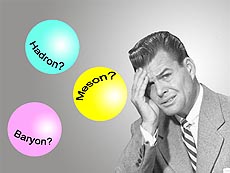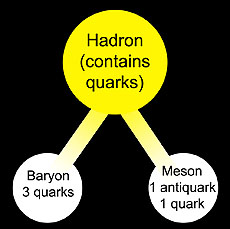What are hadrons, baryons and mesons?
 |
| Hadron? Baryon? Meson? What's what? Who's who? And why do physicists insist on tacking the suffix "on" onto the name of just about every particle they encounter? |
Unlike the NFL, it is common in high-school football that a team's jerseys won't have the players' names emblazoned on the back. That can make watching a game very confusing for the casual spectator. While the experts know who is who without thinking, the casual spectator can easily lose track of which player is which without a list that links each jersey's number with the player's name.
Particle physics has some of the same problems with all of those particle names ending with "on." It's enough to give you a massive headache. Insiders recognize them on sight, but for non-experts, a list identifying them would be very helpful. In this week's Nutshell, we are going to identify three of them and explain how they are related. The three classes of particles are hadrons, mesons and baryons.
First off, all three terms identify classes of particles. Hadrons are particles that experience the strong nuclear force. This means that they contain quarks. A baryon is a type of hadron, and it contains three quarks. A meson is also a type of hadron, and it contains one quark and one antiquark. Making an analogy to the animal kingdom, the term hadron corresponds to the term animal, while the terms meson and baryon might correspond to the classifications mammal and reptile.
Historically, the name baryon implied a heavy subatomic particle, while the term meson was given to particles with much lower masses. This can be seen from the words' Greek etymological roots—"barys" for heavy and "mesos" for intermediate. (There are also particles called leptons, from the Greek "leptos," meaning light, but these particles are not hadrons and are not discussed here.) In the 1960s, the identification of baryons as heavy particles and mesons as particles of intermediate mass was absolute. But the discovery of the heavier charm and bottom quark ruined that connection—it turned out they could make up mesons that were heavier than the earliest-discovered baryons. Thus in the modern world, the quark content is the only thing that identifies a hadron as a baryon or a meson.
One thing that mesons and baryons have in common is that, even though their constituent quarks carry color, they themselves do not—they're color-neutral. That is, it is their quark and gluon constituents that carry the charge of the strong force, not the mesons and baryons that comprise them.
In short, hadrons are particles containing quarks. Baryons are hadrons containing three quarks, and mesons are hadrons containing a quark and an antiquark. Hopefully the next time you encounter these terms, you won't have to reach for the Tylenol.
—Don Lincoln
Want a phrase defined? Have a question? E-mail today@fnal.gov.
 |
| Baryons and mesons are examples of hadrons. Any particle that contains quarks and experiences the strong nuclear force is a hadron. Baryons have three quarks inside them, while mesons have a quark and an antiquark. |
|